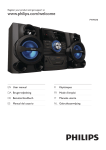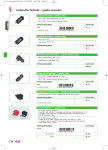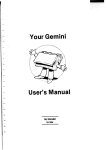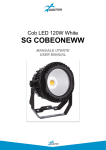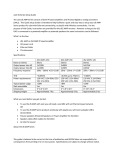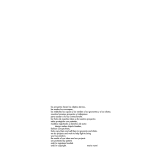Download Braun i-soamp-4cx User's Manual
Transcript
i-soamp-2 / i-soamp-4 i-soamp-4cx Car-Audio-Amplifiers by manual Germany intelligent solutions and technologies D i-soamp-4, i-soamp-2, i-soamp-4cx Wir beglückwünschen Sie zum Kauf dieses i-sotec Produktes und danken für Ihr Vertrauen! Mit diesem Car-Audio-Gerät haben Sie ein technologisch ausgereiftes und innovatives Produkt erworben, das Ihnen viele Jahre hervorragenden Musikgenuss ermöglichen wird. In i-sotec Produkten steckt die gesammelte Erfahrung unserer Ingenieure, Redakteure der Fachzeitschriften und nicht zuletzt auch Car-Audio-Händler, durch die wir viele Anregungen bekommen haben. Der i-soamp ist ein Car-Audio-Verstärker, der speziell für den Einsatz in Fahrzeugen mit fest eingebautem (OEM) Autoradio konzipiert wurde. Eine komplette Adapterlinie ermöglicht den Anschluss ohne aufwendige Verkabelungsarbeiten bei mehr als 500 Fahrzeugtypen. Natürlich kann der isoamp auch mit jedem handelsüblichen Autoradio betrieben werden. Es besteht außerdem die Möglichkeit, die Kanäle in Brücke zu schalten, um so mit annähernd der doppelten Leistung Subwoofer betreiben zu können. Die vielfältigen Einstell- und Anpassungsmöglichkeiten machen den i-soamp zum Allround-Genie im Auto. Bitte lesen Sie vor Installation und Inbetriebnahme diese Anleitung sorgfältig durch, um Bedienungsfehler zu vermeiden. Im Zweifelsfall wenden Sie sich bitte an Ihren Fachhändler. BESTIMMUNGSGEMÄßER GEBRAUCH: Der i-soamp ist ausschließlich für den Betrieb im Fahrzeug am 12V KfzBordnetz und am Original-Lautsprecher-Kabelbaum sowie mit Original i-sotec Adapterkabeln und i-sotec Subwoofern (optional) vorgesehen. Andere Adapterkabel und Subwoofer können den i-soamp beschädigen. Der i-soamp nimmt die Audiosignale des OEM Radios auf und führt sie den Fahrzeuglautsprechern verstärkt wieder zu Inhalt: A Einbauanleitung, Fehlersuche, technische Daten B Bedienungsanleitung i-soamp-4 C Bedienungsanleitung i-soamp-2 D Bedienungsanleitung i-soamp-4cx i-soamp-4, i-soamp-2, i-soamp-4cx UK Congratulations on your purchase of this i-sotec product, and thank you for your trust! With this i-sotec-amplifier you have acquired a technologically fully developed and innovative product that will give you many years of outstanding music enjoyment. i-sotec products contain the sum of experience gained over many years by our engineers, editors of specialist publications and not least the car audio dealers who have given us many ideas. The i-soamp was specifically designed for use in cars with integral (OEM) car radios. A complete adaptor range permits connections without elaborate cabling work to more than 500 vehicle models. The i-soamp can, of course, also be operated with any standard commercial car radio. Alternativlye the channels may be configured to bridge mode to enable a subwoofer to be operated with nearly twice the output. The many adjustment and adaptation possibilities make the i-soamp an all-round genius for your car. Please read these instructions carefully before installation and operation to avoid operating problems. If in doubt, please consult your specialist dealer. INTENDED USE: The i-soamp is exclusively intended for operation in a car with a 12V electrical system and the original loudspeaker cable harness. It takes the audio signals of the OEM radio and conducts them to the vehicle loudspeakers in amplified form. Content Of This Manual A Installation Guide, Troubleshooting, Technical Data B User’s Guide i-soamp-4 C User’s Guide i-soamp-2 D User’s Guide i-soamp-4cx A INSTALLATION Achten Sie bei der Installation unbedingt auf eine gute Belüftung des Gerätes. Es darf nicht abgedeckt oder in der Nähe anderer Wärme abstrahlender Gegenstände montiert oder direkter Sonneneinstrahlung ausgesetzt werden! Der i-soamp kann sich selbst stark erwärmen (bis zu 80°C), daher ist auf ausreichenden Abstand zu anderen wärmeempfindlichen Fahrzeugteilen (insbesondere Kunststoffteile und elektronische Komponenten) zu achten! Aus Sicherheitsgründen muss das Gerät fest im Fahrzeug installiert werden. Befestigen Sie das Gerät mit den mitgelieferten Montageschrauben an einem festen und geeigneten Untergrund. Bohren Sie keine Löcher in Teile des Fahrzeuges, wenn Sie nicht wissen, was sich dahinter befindet. Achten Sie auf Kabelbäume und Benzinleitungen! D Lieferumfang Die i-sotec Car-Audio-Systeme werden mit folgendem Zubehör geliefert: 1. Verstärkereinheit 2. Handbuch 3. Iso-Stromadapter 4. i-sotec Kabelbaum 5. Befestigungsschrauben (4 Stück, ohne Abbildung) 6. Remote-Kabel (nur i-soamp-2, ohne Abbildung) A1 ANSCHLUSS Der i-soamp wird mittels original i-sotec Adapter direkt an den FahrzeugKabelbaum und an das Originalradio angeschlossen. Bei Fahrzeugtypen ohne ISO Anschluss wird hierfür zusätzlich ein fahrzeugspezifischer Adapter benötigt. Überprüfen Sie bitte anhand der i-sotec Fahrzeugliste, ob Sie zum Anschluss des i-soamp an Ihrem Fahrzeug einen zusätzlichen Adapter benötigen. Sie können dies auch online unter http://www.i-sotec.com feststellen. A INSTALLATION When installing the equipment, be sure that it is well ventilated. It must not be covered or mounted near heat emitting objects or be subjected to direct sunlight. The i-soamp can heat itself up significantly (up to 80°C); it is therefore important to ensure sufficient clearance from other heat-sensitive vehicle components (particulary plastic-parts and electronic components)! For safety reasons, the device must be securely mounted in the vehicle. Attach the device with the supplied mounting screws to a firm and suitable base. Do not drill holes in parts of the vehicle if you are not sure what is located behind. Watch out for wiring harnesses and fuel lines!!! UK A.1.Accessorys The i-soamp package includes the following accessorys: 1. Amplifier unit 2. Manual 3. Iso-power plug 4. Wiring harness 5. Fastening screws (4 pieces, not in picture) 6. Remote cable (i-soamp-2 only, not in picture) A1 Connection The i-soamp is connected directly to the vehicle cable harness and to the original radio with an adaptor. Vehicle models without an ISO connection require a special vehicle-specific adaptor for this purpose. Please consult the i-sotec vehicle list to check whether you need an additional adaptor to connect the i-soamp to your vehicle. You can do this online as well at http://www.i-sotec.com/ A1.1 Ist-Situation Entfernen Sie das Originalradio gemäß der Anleitung des Fahrzeugherstellers aus dem Radioschacht, damit Sie die rückseitigen Anschlüsse des Radios erreichen können. Wenn Ihr Originalradio einen ISO Anschluss hat, finden Sie – ggfs. neben anderen Anschlüssen wie z.B. dem Antennenkabel folgende zwei Stecker, die sich nach Zusammendrücken der seitlichen Verriegelung vom Radio entfernen lassen: D ISO-Stecker für den Lautsprecheranschluss (Bild 1) Dieser Stecker (im Folgenden als ISO-Lautsprecherstecker bezeichnet) ist daran zu erkennen, dass die Verriegelung mittig an der schmalen Seite des Steckers angeordnet ist. Abgesehen davon ist der Stecker meistens aus braunem Kunststoff und die anschließenden Lautsprecherkabel sind üblicherweise grau und weiß. Die Farbkodierungen werden allerdings nicht einheitlich bei allen Fahrzeugherstellern eingehalten und können variieren. ISO-Stecker für den Stromanschluss (Bild 2) Dieser Stecker (im Folgenden als ISO-Stromstecker bezeichnet) ist eindeutig daran zu erkennen, dass die Verriegelung nicht mittig an der schmalen Seite des Steckers angeordnet ist. Der Stecker ist meistens aus schwarzem Kunststoff. An diesen Stecker schließen üblicherweise ein rotes, ein schwarzes, ein gelbes sowie weitere farbige Kabel an. Die Gegenstücke zu den ISO-Steckern sind die ISOKupplungen (Bild 3). Die ISO-Kupplung für den Lautsprecheranschluss (ISO-Lautsprecherkupplung) lässt sich nur mit den passenden ISO-Lautsprechersteckern verbinden. Die entsprechende Nut mittig an der schmalen Seite der Kupplung stellt dies sicher. Die ISO-Kupplung für den Stromanschluss (ISO-Stromkupplung) lässt sich ebenfalls nur mit den passenden ISO-Stromsteckern verbinden. Auch hier stellt eine entsprechende Nut seitlich an der schmalen Seite der 4 Kupplung dies sicher. Bei den meisten Radios sind diese Kupplungen direkt im Gehäuse als „Steckdosen“ integriert. Um die vorhandenen ISO-Stecker, die sich am Kabelbaum des Fahrzeugs befinden mit dem i-soamp zu verbinden, werden die beiden hier abgebildeten ISO-Kupplungen am i-soamp Kabelbaum verwendet: ISO-Lautsprecherkupplung am i-soamp Kabelbaum (Bild 4) ISO-Stromkupplung am i-soamp Stromadapter (Bild 5) A1.1: Situation as is: Remove the original radio from the radio slot according to the vehicle manufacturer's instructions so that you can get to the terminals on the rear side of the radio. If your original radio has an ISO terminal – possibly next to other terminals such as the antenna cable - you will find the following two plugs which can be removed after pressing together the locking mechanism on the side: UK 1 ISO plug for the loudspeaker connection (Pic. 1) This plug (below also referred to as the ISO loudspeaker plug) can be clearly identified by the fact that the locking mechanism is located in the center of the narrow side of the plug. Apart from that, the plug is usually made of brown plastic and the connected loudspeaker cables are typically grey and white. 2 The color coding, however, is not uniformly maintained by all vehicle manufacturers and can vary. ISO plug for the power connection (Pic. 2) This plug (below also referred to as the ISO power plug) can be clearly identified by the fact that the locking mechanism is not located in the center of 3 the narrow side of the plug. Apart from that, the plug is usually made of black plastic and typically a red, a black, a yellow and additional colored cables are connected to this plug. The color coding, however, is not uniformly maintained by all vehicle manufacturers and can vary. The mating parts for these ISO plugs are called ISO receptacles (Pic. 3). The ISO receptacle for the loudspeaker connection (ISO loudspeaker receptacle) can only be connected to the matching ISO loudspeaker plugs. The ISO coupling for the power connection (ISO power receptacle) can also only be connected to the matching ISO power plugs. Here, too, a corresponding groove located on the side of the coupling ensures the correct connection. In most radios these receptacles are directly recessed in the housing as Terminals. Use the two ISO couplings on the i-soamp cable harness shown here to connect the existing ISO plugs, located in the vehicle's cable harness, to the i-soamp: ISO loudspeaker receptacles on the i-soamp cable harness (Pic. 4) and ISO power receptacle on the i-soamp power adaptor (Pic. 5). 5 A1.2 Überblick: Anschlussprinzip Diese Darstellung soll Ihnen einen Überblick verschaffen, wie der isoamp grundsätzlich mit den Komponenten in Ihrem Fahrzeug verbunden wird. Folgende Schritte sind notwendig, um den i-soamp an Ihrem vorhandenen Autoradio anzuschließen: 1. i-soamp-Kabelbaum mit dem Kompaktstecker am i-soamp anschließen. 2. Stromstecker am i-soamp-Kabelbaum mit der Kupplung des mitgelieferten Stromadapters verbinden. 3. ISO-Lautsprecherkupplung des Fahrzeug-Kabelbaums vom Radio lösen und an der ISO-Lautsprecherkupplung (braun) des i-soamp Kabelbaums verbinden. (Details zu Anschlussvarianten siehe Kapitel A.1.3, A.1.4, A.1.5) 4. Die ISO-Stromkupplung des Fahrzeug-Kabelbaums vom Autoradio lösen und mit der ISOStromkupplung (schwarz) des mitgelieferten Stromadapters verbinden (Details zum Stromanschluss siehe Kapitel A.1.6 und A.1.7) 5. Den ISO-Stromstecker (schwarz) des mitgelieferten Stromadapters mit der ISO-Stromkupplung des Autoradios verbinden. 6. Den ISO-Lautsprecherstecker (braun) des i-soamp-Kabelbaums mit der ISO-Lautsprecherkupplung des Autoradios verbinden. Lesen Sie auf jeden Fall die folgenden Kapitel, bevor Sie mit dem Anschließen beginnen, um die Details der einzelnen Anschlussvarianten zu erfahren. D Alternativer Anschluss über Cinch-Kabel (nur i-soamp-4cx) Falls Ihr Autoradio einen Vorverstärker-Ausgang hat (Cinch-Anschlüsse), können Sie, abweichend von den vorab beschriebenen Anschlussvarianten, ihr Radio auch über Cinch-Kabel (nicht mitgeliefert) mit dem i-soamp-4cx verbinden. Details dazu finden Sie in der Bedienungsanleitung für den i-soamp-4cx (Kapitel D3). A1.2 Overview – The i-soamp connection principle This depiction is designed to give you an overview of how the i-soamp is connected to your vehicle's components in principle. UK The following steps are required to connect the i-soamp to your existing car radio: 1. Connect the i-soamp cable harness to the compact plug on the i-soamp. 2. Connect the power plug on the i-soamp cable harness to the power receptacle of the supplied power adaptor. 3. Remove the ISO loudspeaker receptacle of the vehicle's cable harness from the car radio and connect it to the ISO loudspeaker coupling (brown) of the i-soamp cable harness. (For details on connection variants see Chapter A1.3,A1.4 and A1.5) 4. Remove the vehicle cable harness ISO power coupling from the car radio and connect it to the ISO power coupling (black) of the supplied power adaptor (For details on the power connection see Chapter A1.6 and A1.7) 5. Connect the ISO power plug (black) of the supplied power adaptor to the ISO power receptacle of the car radio. 6. Connect the ISO loudspeaker plug (brown) of the i-soamp cable harness to the ISO loudspeaker receptacle of the car radio. In any case, be sure to read the following chapter before you start connecting the i-soamp to find out about the details of the individual connection options . Alternative connection via RCA plugs (i-soamp-4cx only) If you own a Radio with preamp outputs (RCA sockets) you can also connect the radio via RCA plugs to the i-soamp-4cx. For details, see the i-soamp-4cx user’s guide (chapter D3). A1.3 Anschlussvariante „Normal” (i-soamp-2/4/4cx) Der i-soamp-4 wird mit den Front- und RearLautsprechern (i-soamp-2: Nur Front) verbunden. Der Wahlschalter wird hierzu auf die Position „Normal“ gestellt. Das bedeutet, dass alle angeschlossenen Lautsprecher „Fullrange“, also ohne Beeinflussung des Frequenzgangs, betrieben werden. Nachdem man den Kabelbaum des i-soamp mit dem Kompaktstecker am i-soamp angeschlossen hat, werden die Lautsprecher folgendermaßen angeschlossen: 1. Den ISO-Lautsprecherstecker des Fahrzeugkabelbaums vom Autoradio trennen und mit der ISOLautsprecherkupplung (braun) des i-soampKabelbaums verbinden. 2. Die 4-poligen Stecker bleiben paarweise miteinander verbunden (wie im Auslieferungszustand) 3. ISO-Lautsprecherkupplung des i-soampKabelbaums mit ISO-Lautsprecherkupplung des Radios verbinden. 4. Der Stromanschluss erfolgt gemäß Kapitel A.1.6 bzw. A.1.7 D A1.4 Anschlussvariante „Front und Subwoofer“ (i-soamp-4/4cx) Bei dieser Variante werden die vorderen Lautsprecher und der optionale Subwoofer mit dem i-soamp angetrieben. Die hinteren Lautsprecher können durch Umstecken der vierpoligen Stecker (siehe Abbildung) direkt mit dem Radio verbunden werden. Verwenden Sie ausschließlich Original Subwoofer von i-sotec! Andere Lautsprecher können den i-soamp beschädigen! Der Wahlschalter wird bei dieser Anschlussvariante auf die Position „Front+Sub“ gestellt. In dieser Schalterposition werden die benötigten aktiven Filter für den Basslautsprecher und die vorderen Lautsprecher automatisch aktiviert. Die 1.3 "Normal" loudspeaker connection option (i-soamp-2/4/4cx) The i-soamp is connected to the front and back speakers (i-soamp-2: front only). The selector switch is set to the "normal" position. This means that all loudspeakers are operated without affecting the frequency response. After the i-soamp cable harness has been connected to the compact plug on the isoamp, the loudspeakers are connected as follows: 1. Remove the vehicle cable harness ISO loudspeaker plug from the car radio and connect it to the ISO loudspeaker receptacle (brown) of the i-soamp cable harness. 2. The two 4-pole plugs stay connected (as it is when delivered) 3. Connect the ISO loudspeaker plug of the i-soamp cable harness with the car radio ISO loudspeaker receptacle. 4.The power connection is performed in accordance with Chapter A.1.6 and/or A.1.7 UK A.1.4 Front + Subwoofer (i-soamp-4/4cx) With this connection, the front speakers and the optional subwoofer are driven by the i-soamp. The back speakers can be connected directly to the radio by by switching the 4-pinned plugs (see picture). Do only use i-sotec subwoofers! Other speakers can damage the i-soamp. The selector switch is turned to “Front + Sub” position. This means that the active filters required for subwoofer operation ara automatically activated. The volume basic setting for the front speakers is done with the front level control. The Pegeleinstellung für die vorderen Lautsprecher erfolgt über den Regler Level Front. Der Subwoofer wird über den Regler Level Rear geregelt. Nachdem der Kabelbaum des i-soamp mit dem Kompaktstecker am isoamp angeschlossen ist, werden die Lautsprecher folgendermaßen angeschlossen: 1. ISO-Lautsprecherstecker des Fahrzeugkabelbaums (vom Radio trennen) mit ISO-Lautsprecherkupplung (braun) des i-soamp-Kabelbaums verbinden. 2. Die Verbindungen der 4-poligen Stecker lösen und dann, wie auf der Abbildung zu sehen, miteinander verbinden. Es werden dabei die beiden 4poligen Stecker, die sich an der ISO-Lautsprecherkupplung und an dem ISOLautsprecherstecker befinden, miteinander verbunden. 3. Den Subwoofer mit dem zugehörigen Anschlusskabel am passenden Stecker des i-soamp-Kabelbaums anschließen. 4. Die ISO-Lautsprecherkupplung des i-soamp-Kabelbaums mit der ISOLautsprecherkupplung des Autoradios verbinden. 5. Stromanschluss: Siehe Kapitel A.1.6 bzw. A.1.7. subwoofer level is adjusted via the rear level control. After the i-soamp cable harness has been connected to to the compact plug on the i-soamp, the loudspeakers are connected as follows: 1. Remove the vehicle cable harness ISO loudspeaker plug from the car radio and connect it to the ISO loudspeaker recaptacle (brown) of the i-soamp’s cable harness. 2. Disconnect the 4-pinned plugs and connect them as seen in the picture. This way the 4-pinned plugs on the ISO Loudspeaker socket and on the ISO loudspeaker plugs are connected. 3. Connect the i-sotec subwoofer with it’s delivered cable to the fitting plug on the i-soamp’s cable harneess. 4. Connect the ISO loudspeaker plugs of the i-soamp cable harness to the ISO loudspeaker sockets of the car radio. 5. 6. The power connection is made in accordance with Chapter A.16 or A.1.7.. A1.5 Anschlussvariante „Vier Lautsprecher und Subwoofer” (i-soamp-4/4cx) Bei dieser Variante werden die vorderen Lautsprecher und die hinteren Lautsprecher mit dem i-soamp angetrieben. Der Basslautsprecher wird mit einem optionalen i-soamp-2 angetrieben. Die Signalverteilung für die Verstärker erfolgt über den separat erhältlichen Y-Adapter AD-0124 von i-sotec. Verwenden Sie ausschließlich Original Subwoofer von i-sotec! Andere Lautsprecher können den i-soamp beschädigen! Durch den erhöhten Strombedarf der beiden Verstärker ist es wichtig, dass sie direkt an die Batterie angeschlossen werden. Weitere Informationen hierzu siehe Kapitel A.1.7 Der Wahlschalter des i-soamp wird bei dieser Anschlussvariante auf die Position „4CH+Sub“ gestellt. In dieser Schalterposition werden die benötigten aktiven Filter für die vorderen und hinteren Lautsprecher automatisch aktiviert. Der Lautsprecheranschussplan für den i-soamp entspricht dem Anschlussplan in Kapitel A.1.3 (Lautsprecher-Anschlussvariante „Normal“). Die Einstellung für den Wahlschalter des i-soamp-2 und den Lautsprecheranschlussplan sowie Hinweise zur Verwendung des YAdapters AD-0124 entnehmen Sie bitte der Bedienungsanleitung des i-soamp-2 in Kapitel A1.5A A.1.5 Four loudspeakers + Subwoofer (i-soamp-4/4cx) With this connection option, the front and rear loudspeakers are driven by the i-soamp while the bass loudspeaker is driven by an additional i-soamp-2 two-channel-amplifier. Signal distribution for the amplifiers is performed via a separate split-adaptor AD-0124 available from i-sotec. Use only original i-sotec subwoofers! Other loudspeakers can damage the i-soamp! Due to the increased power demand for these two amplifiers it is important to connect the amplifiers directly to the battery. See Chapter A.1.7 for additional information. With this connection option, the selector switch for the i-soamp-4 or -4cx is set to the "4CH+Sub" position. In this switch position the active filters required for the front and rear loudspeakers are automatically activated. The two amplifiers have a max. current requirement of 15A per amplifier. In a few vehicles and when connecting to two amplifiers, the radio wiring cannot cover this power requirement. The i-soamps must then be connected directly to the battery. (See Chapter A.1.7) The wiring diagram is the same as described in Chapter A.1.2. Instead of the car radio ISO loudspeaker receptacle, however, now the free ISO loudspeaker receptacle of the split-adaptor AD-0124 is to be used to connect the cable harness of the i-soamp-2 to the car radio. For more details on connecting the i-soamp-2, see chapter A1.5A. D UK 1.4A Anschlussvariante „Front + Subwoofer“ (i-soamp2) Bei dieser Anschlussvariante werden die vorderen Lautsprecher mit einem i-soamp 2 und der Subwoofer mit einem weiteren i-soamp-2 angetrieben. Die Signalverteilung für die Verstärker erfolgt über den separat erhältlichen YAdapter AD-0124 von i-sotec. Verwenden Sie ausschließlich Original Subwoofer von i-sotec! Andere Lautsprecher können den i-soamp-2 beschädigen! Durch den erhöhten Strombedarf dieser beiden Verstärker ist es wichtig, dass mindestens ein Verstärker direkt an die Batterie angeschlossen wird. Weitere Informationen hierzu im Kapitel 1.7. Der Wahlschalter für den i-soamp 2, der die vorderen Lautsprecher antreibt, wird bei dieser Anschlussvariante auf die Position „2CH+Sub (extern)“ gestellt (siehe obere Abbildung). In dieser Schalterposition werden die benötigten aktiven Filter für die vorderen Lautsprecher automatisch aktiviert. Der Wahlschalter für den i-soamp 2, der den Subwoofer antreibt, wird auf die Position „Sub “ gestellt (siehe untere Abbildung). In dieser Schalterposition werden die benötigten aktiven Filter für den Subwoofer automatisch aktiviert. Nachdem man den Kabelbaum des i-soamp-2 mit dem Kompaktstecker am i-soamp-2 angeschlossen hat, wird der Subwoofer folgendermaßen angeschlossen: 1. Der ISO-Lautsprecherstecker des Fahrzeugkabelbaums wird vom Autoradio getrennt. Der ISO-Lautsprecherstecker des Y-Kabels ADP-0124 wird an der ISOLautsprecherkupplung des Autoradios angeschlossen. 2. Der ISO-Lautsprecherstecker des i-soamp-Kabelbaums wird an einer der beiden ISO-Lautsprecherkupplungen des Y-Kabels angeschlossen. 3. Die ISO-Lautsprecherkupplung des i-soamp-Kabelbaums wird nicht verwendet. 4. Die zwei 4-poligen Stecker werden getrennt. 5. Der 4-polige Stecker am i-soamp-Kabelbaum dient als Anschluss für den Subwoofer. Verwenden Sie für den Anschluss bitte das Original Anschlusskabel des i-sotec Subwoofers oder das Adapterkabel AD-0126 (Subwoofer Anschlusskabel 5m). 6. Der Stromanschluss erfolgt gemäß Kapitel 1.7 7. Die freie ISO-Lautsprecherkupplung am Y-Kabel dient zum Anschluss des zweiten i-soamp-2, der die Frontlautsprecher antreibt. D Der i-soamp-2, welcher die Frontlautsprecher antreibt, wird wie in Kapitel A1.3 beschrieben angeschlossen. Anstelle der ISO-Lautsprecherkupplung des Autoradios ist nun allerdings die freie ISOLautsprecherkupplung des Y-Kabels ADP-0124 zu verwenden, um den Kabelbaum des i-soamp-2 mit dem Autoradio zu verbinden (Kapitel A1.3, Punkt 3). 1.4A Loudspeaker connection option "Front + Subwoofer (i-soamp 2) For this connection option, the front loudspeakersand the bass speaker are driven by an i-soamp-2 each. Signal distribution for the amplifiers is performed with a split-adaptor (AD-0124). Use only original i-sotec subwoofers! Other loudspeakers can damage the i-soamp-2! Due to the increased power requirements of these two amplifiers it is important to connect at least one amplifiers directly to the battery. For further information, see Chapter A1.7. For this connection option, the first i-soamp-2 selector switch is set to the 24CH+Sub" position. In this position the active filters required for the loudspeakers are automatically activated. The other i-soamp-2 selector switch is set to the "Sub" position. In this switch position the active filters required for the bass speaker are automatically activated. (Wiring diagram see Normal + Sub) UK After the cable harness of the i-soamp-2 has been connected to the compact plug at the isoamp-2, the subwoofer is connected as follows: 1. The vehicle cable harness ISO loudspeaker plug is removed from the car radio. The ISO loudspeaker of the Y cable ADP-0124 is connected to the ISO loudspeaker receptacle of the car radio. 2. The ISO loudspeaker of the i-soamp cable harness is connected to one of the two ISO loudspeaker receptacles of the split-adaptor. 3. The ISO loudspeaker receptacle of the i-soamp cable harness is not used. 4. The two 4-pole plugs are removed. 5. The 4-pole plug at the i-soamp cable harness serves as a connector for the subwoofer. Please use the original i-sotec subwoofer connector cable for the connection or the adaptor cable AD-0126 (subwoofer connector cable 5m). 6. The power connection is made in accordance with ChapterA1.7 7. The free ISO loudspeaker receptacle at the split-adaptor is used for connecting the second i-soamp-2, which drives the front loudspeakers. The i-soamp-2, which drives the front speakers, is connected as described in Chapter A1.3. Instead of the ISO loudspeaker receptacle of the car radio, however, now the free ISO loudspeaker receptacle of the splitadaptor ADP-0124 is to be used to connect the cable harness of the i-soamp-2 to the car radio (Chapter A1.3, point 3). A1.4B Nur Subwoofer (i-soamp-2) Bei dieser Anschlussvariante betreibt der i-soamp-2 einen Subwoofer, während die Fahrzeug-Lautsprecher ohne zusätzliche Verstärkung direkt vom Autoradio angetrieben werden. Die Signalverteilung für die Verstärker erfolgt über den separat erhältlichen Y-Adapter AD-0124 von i-sotec. Verwenden Sie ausschließlich Original Subwoofer von i-sotec! Andere Lautsprecher können den i-soamp-2 beschädigen! Der Wahlschalter des i-soamp-2 wird auf die Position „Sub“ gestellt. In dieser Schalterposition werden die benötigten aktiven Filter für den Basslautsprecher automatisch aktiviert. Der Anschluss entspricht der Variante “Front+Subwoofer” (Abb. siehe vorherige Seite): 1. Der ISO-Lautsprecherstecker des Fahrzeugkabelbaums wird vom Autoradio getrennt. Der ISO-Lautsprecherstecker des Y-Kabels ADP-0124 wird an der ISOLautsprecherkupplung des Autoradios angeschlossen. 2. Der ISO-Lautsprecherstecker des i-soamp-Kabelbaums wird an einer der beiden ISO-Lautsprecherkupplungen des Y-Kabels angeschlossen. 3. Die ISO-Lautsprecherkupplung des i-soamp-Kabelbaums wird nicht verwendet. 4. Die zwei 4-poligen Stecker werden getrennt. 5. Der 4-polige Stecker am i-soamp-Kabelbaum dient als Anschluss für den Subwoofer. Verwenden Sie für den Anschluss bitte das Original Anschlusskabel des i-sotec Subwoofers oder das Adapterkabel AD-0126 (Subwoofer Anschlusskabel). 6. Der Stromanschluss erfolgt gemäß Kapitel 1.7 7. Die freie ISO-Lautsprecherkupplung am Y-Kabel dient zum Anschluss des ISOLautsprechersteckers am Fahrzeug-Kabelbaum. D A1.5A Vier Lautsprecher + Subwoofer (i-soamp2) Bei dieser Anschlussvariante werden die vorderen Lautsprecher und die hinteren Lautsprecher mit einem i-soamp-4, der Basslautsprecher mit einem i-soamp-2 angetrieben. Die Signalverteilung für die Verstärker erfolgt über den separat erhältlichen Y-Adapter AD-0124 von i-sotec. Verwenden Sie ausschließlich Original Subwoofer von i-sotec! Andere Lautsprecher können den i-soamp-2 beschädigen! Durch den erhöhten Strombedarf dieser beiden Verstärker ist es wichtig, dass mindestens ein Verstärker direkt an die Batterie angeschlossen wird. Weitere Informationen hierzu im Kapitel A1.7. Der Wahlschalter des i-soamp-4 wird bei dieser Anschlussvariante auf die Position „4CH+Sub“ gestellt. In dieser Schalterposition werden die benötigten aktiven Filter für die vorderen und hinteren Lautsprecher automatisch aktiviert. Der Wahlschalter des i-soamp-2 wird auf die Position „Sub“ gestellt. In dieser Schalterposition werden die benötigten aktiven Filter für den Basslautsprecher automatisch aktiviert. Anschlussplan i-soamp-2 für den Subwoofer: Wie in Kapitel 1.4 / „Lautsprecheranschlussplan Subwoofer“ beschrieben Anschlussplan i-soamp-4 für die vorderen und hinteren Lautsprecher: Wie in der Anleitung i-soamp-4 beschrieben. Anstelle der ISO-Lautsprecherkupplung des Autoradios ist nun allerdings die freie ISO-Lautsprecherkupplung des Y-Kabels ADP-0124 zu verwenden, um den Kabelbaum des i-soamp-4 mit dem Autoradio zu verbinden (A 1.2, Punkt 1). A1.4B Sub only (i-soamp-2) With this connection option the bass loudspeaker is driven by an isoamp-2, while the other loudspeakers are driven directly b<y the radio without additional amplification. Signal distribution for the amplifiers is performed via a separate split-adaptor AD-0124 available from isotec. Use only original i-sotec subwoofers! Other loudspeakers can damage the i-soamp-2! In this connection option, the selector switch for the i-soamp 2 is set to the "sub" position. In this switch position the active filters required for the bass loudspeaker are automatically activated. The wiring diagram is as described in the option “Front+Subwoofer” (for pictures, see previous page) 1. The vehicle cable harness ISO loudspeaker plug is removed from the car radio. The ISO loudspeaker plug of the Y cable ADP-0124 is connected to the ISO loudspeaker receptacle of the car radio. 2. The ISO loudspeaker plug of the i-soamp cable harness is connected to one of the two ISO loudspeaker receptacles of the split-adaptor. 3. The ISO loudspeaker receptacle of the i-soamp cable harness is not used. 4. The two 4-pole plugs are removed. 5. The 4-pole plug at the i-soamp cable harness serves as a connector for the subwoofer. Please use the original i-sotec subwoofer connector cable for the connection or the adaptor cable AD-0126 (subwoofer connector cable 5m). 6. The power connection is made in accordance with Chapter A1.6 or A1.7. 7. The free ISO loudspeaker receptacle at the split-adaptor is used for connecting the car’s loudspeaker plugs. UK A1.5A Four loudspeakers + Subwoofer (i-soamp 2) With this connection option the front and rear loudspeakers are driven by an i-soamp-4. The bass loudspeaker is driven by an i-soamp-2. Signal distribution for the amplifiers is performed via a separate split-adaptor AD-0124 available from i-sotec. Use only original i-sotec subwoofers! Other loudspeakers can damage the i-soamp-2! Due to the increased power demand for these two amplifiers it is important to connect at least ona amplifier directly to the battery. See Chapter 1.7 for additional information. With this connection option, the selector switch for the i-soamp 4 is set to the "4CH+Sub" position. In this switch position the active filters required for the front and rear loudspeakers are automatically activated. In this connection option, the selector switch for the i-soamp 2 is set to the "sub" position. In this switch position the active filters required for the bass loudspeaker are automatically activated. Wiring diagram for i-soamp-2 for the subwoofer: As described in Chapter 1.4B / "Loudspeaker wiring diagram subwoofer." Wiring diagram i-soamp-4 for the front and rear loudspeakers: As described in Chapter 1.2 of the instructions for isoamp-4. Instead of the car radio ISO loudspeaker receptacle, however, now the free ISO loudspeaker receptacle of the split-adaptor ADP-0124 is to be used to connect the cable harness of the i-soamp2 to the car radio (Chapter 1.2, point 1). A1.6 Anschluss der Spannungsversorgung Der i-soamp wird mit einem ISO Stromadapter ausgeliefert. Der Adapter wird zwischen Autoradio und Fahrzeug-Kabelbaum angeschlossen. 1. ISO-Stromstecker des Fahrzeugkabelbaums vom Autoradio trennen und an der ISO-Stromkupplung des i-sotec Stromadapters anschließen. 2. 2-poligen Stecker am Kabelbaum des i-soamp mit der 2-poligen Kupplung am Stromadapter verbinden. An dieser Steckverbindung können ggfs. auch andere fahrzeugspezifische Adapter mit dem i-soamp verbunden werden. 3. ISO-Stromstecker des i-sotec Stromadapters mit der ISOStromkupplung des Autoradios verbinden. Da verschiedene Fahrzeughersteller die Anschlüsse für 12V Dauerplus (Memory, gelb) und 12V Versorgungsspannung (an Zündung gekoppelt, rot) am ISO-Stecker vertauschen, besitzt der i-sotec Stromadapter zwei alternative Steckverbindungen für Dauerplus: A. Standardanschluss für Dauerplus (Auslieferungszustand) B. Alternative Kupplung für Dauerplus Die korrekte Zuordnung ist im Zweifelsfall mit einem Voltmeter oder Prüflampe zu testen. Diejenige 1-polige Kupplung (A oder B), an der auch bei ausgeschalteter Zündung +12V Spannung gegen Masse gemessen wird, ist mit dem zugehörigen 1-poligen Stecker zu verbinden. D A1.7 Direkter Anschluss der Batterie Die i-soamp Verstärker müssen unter bestimmten Umständen direkt an der Batterie Ihres Fahrzeugs angeschlossen werden. Dies ist der Fall, wenn Sie Schwierigkeiten damit haben, den Strombedarf des i-soamp über den mitgelieferten ISO-Stromadapter zu decken oder wenn Sie mehrere i-soamp Verstärker in Ihrem Fahrzeug einsetzen. i-sotec empfiehlt für den direkten Anschluss des isoamp Verstärkers an der Fahrzeugbatterie das i-sotec Stromanschlusskabel „AD-0125“ zu verwenden. Wichtig: Vor dem elektrischen Anschluss des Gerätes an das 12V Bordnetz Ihres Fahrzeuges muss die Fahrzeugbatterie abgeklemmt werden! 1. Das Stromanschlusskabel ist im Fahrzeug so zu verlegen, dass das Kabelende mit dem Adapterstecker am Ende des i-soamp Kabelbaums und das andere Ende in der Nähe der Autobatterie liegt. Es ist darauf zu achten, dass das Kabel knickfrei verlegt wird. Kontakt mit scharfkantigen Blechteilen ist zu vermeiden, die Verwendung von Gummi-Durchführungen wird empfohlen. Falls notwendig, kann das Stromanschlusskabel nach der Verlegung am Ende in der Nähe der Batterie gekürzt werden. Anmerkung: Das schwarze Kabel innerhalb der Ummantelung des Stromanschlusskabels dient zum Anschluss des Massekontakts, das rote Kabel wird für den Anschluss an +12V verwendet. 2. Zum Anschluss des schwarzen Kabels ist ein geeigneter Massepunkt zu suchen. Er muss einwandfreien Kontakt zum Chassis und dem Minuspol der Batterie haben. Stellen Sie sicher, dass dies der Fall ist und Sie nicht ein Blech wählen, das evtl. nur ans Fahrzeugchassis geklebt wurde. Das schwarze Kabel wird an dem Massepunkt A.1.6 Connection to the power supply The i-soamp and Auxgate are supplied with an ISO power adapter as standard equipment. The power adapter is connected between the car radio and the vehicle cable harness. 1. Remove the vehicle cable harness ISO power plug from the car radio and connect it to the ISO power receptacle of the i-sotec power adapter. 2. Connect the 2-pole plug at the cable harness of the i-soamp to the 2-pole receptacle at the power adapter. Other vehicle-specific adapters can be connected to the i-soamp with this plug-in connection. 3. Connect the ISO power plug of the i-sotec power adapter to the ISO power receptacle of the car radio. Since different vehicle manufacturers switch the connections at the ISO plug for 12V positive plus (memory, yellow) and 12V supply voltage (coupled to the ignition, red), the i-sotec power adapter has two alternative plug-in connectors for positive plus: A. Standard connection for positive plus (as delivered) B. Alternative coupling for positive plus In case of doubt, the correct assignment can be checked with a voltmeter or test lamp. The 1-pin coupling (A or B) at which one measures against ground even with switched off ignition +12V current, is to be connected to the corresponding 1-pin plug. UK A.1.7 Direct connection to the battery Under certain circumstances, the i-soamp amplifiers must be connected directly to your car's battery. This is the case if you have trouble covering the power requirement of the i-soamp amplifier with the supplied ISO power adapter or if you deploy several i-soamp amplifiers in your vehicle. For a direct connection of the i-soamp amplifier to the vehicle battery, i-sotec recommends using the i-sotec power connector cable "AD-0125." Important: Before connecting the device to your car's 12 V electrical system, be sure to disconnect the battery! 1. The power connector cable must be run within the vehicle so that the end of the cable with the adapter plug is located at the end of the i-soamp cable harness and the other cable end near the car battery. It is important to ensure that the cable is run without kinks. Avoid contact with sharp edged metal parts; rubber grommets are recommended. If necessary, the power connector cable can be shortened at the end close to the battery after successfully running it. Note: The black cable inside the power connector cable is used to connect the ground contact; the red cable is used to connect to +12V. 2. A suitable ground connection point on the chassis must be found to connect the black cable. The ground connection point must have perfect contact with the chassis and the battery's negative terminal. Make sure this is the case and that you have not selected a piece angeschlossen, hierbei ist auf guten elektrischen Kontakt zu achten. 3. Das rote Kabel wird über eine geeignete Sicherung am Pluspol der Batterie angeschlossen. Achtung: In das Plus-Kabel MUSS eine Hauptsicherung in maximal 30cm Entfernung von der Plusklemme der Batterie eingefügt werden (Vorschrift der Versicherungen!), die bei mechanischer Beschädigung des Kabels oder bei Chassiskontakt der Stromleitung auslöst, um einen Kabelbrand oder Schlimmeres zu verhindern! Der Wert muss an die gesamte Stromaufnahme der Anlage angepasst sein. Die Sicherung im Kabelbaum des Gerätes schützt nur das Gerät selbst, nicht aber die Batterie und das Fahrzeug! 4. Nach dem ordnungsgemäßen Anschluss der Stromkabel kann die Batterie wieder angeklemmt werden. 5. Der zweipolige Stromanschlussstecker am i-soamp Kabelbaum (siehe Foto, A) wird mit dem Stromanschlusskabel AD-0125 (B) verbunden. of metal that was only glued to the vehicle chassis. The black cable is connected to the grounding point; make sure there is a good electrical contact. 3. The red cable is connected to the positive terminal of the battery via a suitable fuse. CAUTION: A main fuse MUST be inserted into the positive cable a maximum of 12"’ (=30cm) distance from the positive battery post (insurance company requirement!). This fuse will blow in the event of mechanical damage to the cable and conductor contact with the chassis to prevent a cable fire or worse! The rating must be appropriate for the total current input of the system. The fuse in the device wiring harness protects only the device itself, but not the battery and the vehicle! Suitable fuse elements can be found in accessories stores. 4. After the power cable is properly connected, the battery can be reconnected. 5. The 2-pin power connector cable at the i-soamp cable harness (see photo, A) is connected to power connector cable AD-0125 (B). A1.8 Warnhinweise Die Sicherung am Gerät darf nur mit dem gleichen Wert (20A) ersetzt werden, um eine Beschädigung des Gerätes zu verhindern. Höhere Werte können zu gefährlichen Folgeschäden führen! Der i-soamp kann höhere Leistungen an die vorhandenen Lautsprecher abgeben als das Original-Radio. Die meisten Lautsprecher können diese problemlos verkraften. Bitte gehen Sie dennoch vorsichtig mit dem Lautstärkeregler um. Vermeiden Sie langzeitige, überhöhte Lautstärken, die sich durch einen unangenehmen verzerrten Klang bemerkbar machen, um eine Beschädigung der Lautsprecher zu verhindern. Es wird empfohlen, die Klangregler (Bässe /Höhen) des Autoradios auf „Neutral“, also in Mittelstellung bzw. „0“ einzustellen. So stellt sich erfahrungsgemäß der beste und natürlichste Klangeindruck ein; eine Überlastung der Lautsprecher wird vermieden. A.1.8 Caution notice: The fuse for the device may only be replaced with a fuse of the same rating (20A) to avoid damage to the device. Higher value fuses can result in dangerous consequences!!! The i-soamp can deliver higher output to the existing loudspeakers than the original radio. Most loudspeakers can handle it with no problem. Nevertheless, please be very careful with the volume control. To prevent damage to the loudspeakers, avoid leaving the volume up too high for long periods, which is noticeable by an unpleasant, distorted sound. It is highly recommended to set the car radio's tone controls (basses/trebles) to "neutral", i.e. to the center point and/or "0". Experience has shown that this is the best setting for the best and most natural sound and avoids overloading the speakers. D A2. Technische Daten Betriebsspannung: 10,4-14,4V DC Strombedarf: Max. 15A Musik Leistung: 4x 65W @ 4 Ohm bzw. 2x65W+1x100W @ 4 Ohm (i-soamp-2: 2 x 85 W @ 4 Ohm bzw. 1 x 120W @ 4 Ohm) (i-soamp-4cx: 4x 70W @ 4 Ohm or 2x70W+1x120W @ 4 Ohm) Lautsprecher Impedanz:: Min. 4 Ohm THD+N: <0,01% SNR: >96dB Max. Umgebungstemperatur: 45°C Abmessungen: (LxHxB) 160 mm x 44 mm x 136 mm (i-soamp-4cx: 210 x 156 x 48 mm) Schutzfunktionen: • Unterspannung (low Batt., LED-GELB): Abschaltung bei <10,2V, wieder Einschaltung bei >11,4V • Übertemperatur (Temp., LED-ROT): Abschaltung bei >80°C, wieder Einschaltung bei <70°C Gewährleistung 24 Monate UK A.2 TECHNICAL DATA Operating voltage: 10 ,4-14,4V DC Required power: Max. 15A Music output: 4x 65W @ 4 Ohm or 2x65W+1x100W @ 4 Ohm (i-soamp-2: 2 x 85 W @ 4 Ohm or 1 x 120W @ 4 Ohm) (i-soamp-4cx: 4x 70W @ 4 Ohm or 2x70W+1x120W @ 4 Ohm) Loudspeaker impedance: Min. 4 Ohm THD+N: <0.01% SNR: >96dB Max. ambient temperature: 45°C Dimensions: (LxHxW) 160 mm x 44 mm x 136 mm (i-soamp-4cx: 210 x 156 x 48 mm) Protective features: • Undervoltage (low batt., LED-YELLOW): switches off at <10,2V, switches on again at >11,4V • Excessive temperature (temp., LED-RED): switches off at >80°C, switches on again at <70°C 24 months Limited Warranty HAFTUNGSAUSSCHLUSS: i-sotec übernimmt keine Haftung für Schäden, die durch unsachgemäßen Gebrauch des Gerätes, unsachgemäße Installation oder falschen Anschluss sowie Nichtbeachtung der in dieser Bedienungsanleitung beschriebenen Handhabungsweisen entstehen könnten. Das Gerät darf nur mit Original i-sotec Adaptersteckern und Kabeln betrieben werden (Weiteres siehe „Bestimmungsgemäßer Gebrauch”) D A.3 Fehlersuche 1. Grüne Funktionsanzeige (Radio ON) leuchtet nicht: • Hauptsicherung oder Gerätesicherung defekt • Radio nicht eingeschaltet • Adapterkabel nicht richtig eingesteckt 2. Rote Übertemperaturanzeige „Temp.“ Anzeige leuchtet: • Überhitzung des Verstärkers. Abkühlen lassen und/oder besser belüftet einbauen. 3. Gelbe Unterspannungs-Anzeige „Low Batt.“ leuchtet: • Batteriespannung ist unter 10,4V gesunken 4. Verzerrter Klang: • Prüfen Sie die Lautsprecher und deren Zuleitungen auf Kurzschlüsse. • Sind die Lautsprecher in Ordnung? • Lautstärke des Radios zu hoch eingestellt. Erhöhen Sie am Verstärker die Front- und Rear Levels. • Gesamtlautstärke zu hoch eingestellt. Reduzieren Sie den Pegel am Radio. 5. Störgeräusche in den Lautsprechern • Schlechter Masseanschluss/-kontakt ? • Mehrere Massepunkte statt einem gemeinsamen verwendet? • Signalkabel in Nähe anderer Fahrzeugkabel verlegt? Konnten Sie den Fehler nicht beheben? Fragen Sie bitte Ihren i-sotec Fachhändler um Rat! LIABILITY EXCLUSION: i-sotec assumes no liability for damage that is caused by improper use of the device, improper installation or incorrect connections or non-observance of the handling instructions described in these operating instructions. The device may only be operated with original i-sotec adapter plugs and cables (for more see "Intended Use"). UK A.3 TROUBLESHOOTING 1. Green power indicator (radio ON) does not light up: • Main fuse or device fuse is defective • Radio is not turned on • Adapter cable not connected properly 2. Red excess temperature indicator "Temp“ lights up: • Overheating of amplifier 3. Yellow undervoltage indicator "Low batt." lights up: • Battery voltage has fallen below 10.4V 4. Distorted sound: • Check the loudspeakers and their supply leads for short circuits. • Are the loudspeakers working properly? • Volume of the radio is set too high. Raise the front and rear levels on the amplifier. • Total volume is set too high. Reduce the level on the radio. 5. Background noises in the loudspeakers • Poor ground connection/contact ? • Did you use several grounding points instead of a single one? • Signal cable installed close to other vehicle cables? Were you unable to solve the problem? Please ask your i-sotec specialist dealer for support! B Bedienung i-soamp-4 B.1 Erste Inbetriebnahme 1. Schalten Sie das Radio mit kleiner Lautstärke ein. 2. Nach der Funktionskontrolle der einzelnen Lautsprecher stellen Sie eine etwas höhere Lautstärke am Radio ein. Justieren Sie jetzt gegebenenfalls mittels der Level-Einsteller der Endstufe die Grundlautstärke der Lautsprecher. Das Lautstärkeverhältnis von Front- und Rear-Lautsprechern, bzw. des Subwoofers, lässt sich nun mit den entsprechenden Level-Einstellern (siehe Bedienelemente) justieren. B.2 Bedienelemente und Anschlüsse 1. Betriebsanzeige (Radio ON) GRÜN 2. Unterspannungsanzeige (Low Batt.) GELB 3. Übertemperaturanzeige (Temp.) ROT 4. Systemstecker (Strom, Lautsprecher Ein- und Ausgänge) 5. Lautstärkeregler Front 6. Lautstärkeregler Rear oder Subwoofer in der Front + Subwoofer Betriebsart 7. Wahlschalter für Betriebsart D C Bedienung i-soamp-2 C.1 Erste Inbetriebnahme 1. Schalten Sie das Radio mit kleiner Lautstärke ein. 2. Nach der Funktionskontrolle der einzelnen Lautsprecher stellen Sie eine etwas höhere Lautstärke am Radio ein. Justieren Sie jetzt gegebenenfalls mittels der Level-Einsteller der Endstufe die Grundlautstärke der Lautsprecher. C.2 Bedienelemente und Anschlüsse 1. Betriebsanzeige (Radio ON) GRÜN 2. Unterspannungsanzeige (Low Batt.) GELB 3. Übertemperaturanzeige (Temp.) ROT 4. Systemstecker (Strom, Lautsprecher Ein- und Ausgänge) 5. Remote-Eingang (Benutzung optional bei Verbindung mit anderen Verstärkern oder Radios, die den i-soamp nicht einschalten können) 6. Lautstärkeregler Front oder Subwoofer 7. Wahlschalter für Betriebsart B User’s Guide i-soamp-4 UK B.1. OPERATING THE EQUIPMENT FOR THE FIRST TIME 1. Turn on the radio with the volume set at low. 2. After checking the operation of the individual loudspeakers, set the volume of the radio a little higher. If appropriate, now use the level adjuster of the power amplifier to adjust the basic volume of the loudspeakers. The volume ratio of the front and rear loudspeakers as well as the subwoofer can now be adjusted with the corresponding level adjusters (see operating elements). B.2 OPERATING ELEMENTS and CONNECTIONS 1. Undervoltage indicator (low batt.) YELLOW 2. Excess temperature indicator (temp.) RED 3. Power indicator (radio ON) GREEN 4. System plug for power, loudspeaker input and output 5. Loudspeaker control front 6. Loudspeaker control rear or subwoofer in front + subwoofer operating mode 7. Selector switch for operating mode C User’s Guide i-soamp 2 1. OPERATING THE EQUIPMENT FOR THE FIRST TIME 1. Turn on the radio with the volume set at low. 2. After checking the operation of the individual loudspeakers, set the volume of the radio a little higher. If appropriate, now use the level adjuster of the power amplifier to adjust the basic volume of the loudspeakers. The volume ratio of the front and rear loudspeakers as well as the subwoofer can now be adjusted with the corresponding level adjusters (see operating elements). 2. OPERATING ELEMENTS and CONNECTIONS 1. Undervoltage indicator (low batt.) YELLOW 2. Excess temperature indicator (temp.) RED 3. Power indicator (radio ON) GREEN 4. System plug for power, loudspeaker input and output 5. Remote input for connecting to the i-soamp-MM. Use of the remote input (Rem.) is optional. Normally the i-soamp-2 is switched on with the radio amplifier. In connection with the i-soamp-MM (Multimedia Version) or with the radio, which cannot switch on the i-soamp-2, this input is needed to switch on the isoamp-2. 6. Loudspeaker control rear or subwoofer in the front + subwoofer operating mode 7. Selector switch for operating mode D Bedienung i-soamp-4cx D.1 Erste Inbetriebnahme 1. Schalten Sie das Radio mit kleiner Lautstärke ein. 2. Nach der Funktionskontrolle der einzelnen Lautsprecher stellen Sie eine etwas höhere Lautstärke am Radio ein. Justieren Sie jetzt gegebenenfalls mittels der Level-Einsteller der Endstufe die Grundlautstärke der Lautsprecher. Das Lautstärkeverhältnis von Front- und Rear-Lautsprechern, bzw. des Subwoofers, lässt sich nun mit den entsprechenden Level-Einstellern (siehe Bedienelemente) justieren. D.2 Bedienelemente und Anschlüsse 1. Betriebsanzeige (Radio ON) GRÜN 2. Unterspannungsanzeige (Low Batt.) GELB 3. Übertemperaturanzeige (Temp.) ROT 4. Systemstecker (Strom, Lautsprecher Ein- und Ausgänge) 5. Remote Eingang. Die Benutzung ist optional. Im Normalfall wird der i-soamp durch den Radioverstärker angeschaltet. In Verbindung mit anderen Verstärkern oder Radios, die den i-soamp nicht einschalten können, sowie beim Anschluss über Cinch-Kabel wird dieser Eingang dafür benötigt. 6. Lautstärkeregler Front 7. Lautstärkeregler Rear oder Subwoofer in der Front + Subwoofer Betriebsart 8. Cinch-Eingang Vorne Links 9. Cinch-Eingang Vorne Rechts 10. Cinch-Eingang Hinten Links 11. Cinch-Eingang Hinten Rechts 12. Wahlschalter für Betriebsart D.3 Anschluss über Cinch-Kabel Falls Ihr Radio einen Vorverstärker-Ausgang hat (Cinch-Anschlüsse), können Sie, abweichend von den vorab beschriebenen Varianten, ihr Radio auch über Cinch-Kabel (nicht mitgeliefert) mit dem i-soamp verbinden. Bitte beachten Sie, dass die CinchEingänge parallel zu den High-Level-Eingängen (Iso-Stecker f. Lautsprecheranschluss) geschaltet sind und daher nur einer dieser Eingänge verwendet werden darf. Stromversorgung und Lautsprecher-Ausgang des i-soamp werden auch in dieser Variante über den i-soamp-Kabelbaum verbunden (Kapitel A1.2 Punkte 1-5). Die SignalÜbertragung vom Radio zum i-soamp erfolgt, abweichend von Kapitel A1.2 Punkt 6, über Cinch-Kabel. Außerdem wird der Remote-Eingang des i-soamp über ein geeignetes Kabel (nicht mitgeliefert) mit dem Remote-Ausgang des Autoradios verbunden. Wenn Sie nicht sicher sind, welches die richtigen Ausgänge und Kabel sind, fragen Sie bitte Ihren Car-Audio-Fachhändler um Rat! In der Anschlussvariante „normal“ (Betrieb der Front- und Rear-Lautsprecher über den i-soamp, siehe auch Kapitel A1.3) werden die vier Cinch-Eingänge des isoamp (Front und Rear Left/Right) per Cinch-Kabel mit den entsprechenden Ausgängen des Radios verbunden. In der Anschlussvariante „Front und Subwoofer“ (Betrieb der Front-Lautsprecher und eines optionalen i-sotec Subwoofers über den i-soamp, siehe auch Kapitel A1.4) werden NUR die Anschlüsse „Front Left“ und „Front Right“ per Cinch-Kabel mit den entsprechenden Ausgängen des Radios verbunden. Nur so ist die für den Subwoofer- betrieb notwendige Frequenzfilterung möglich! D D User’s Guide i-soamp-4cx D.1. OPERATING THE EQUIPMENT FOR THE FIRST TIME 1. Turn on the radio with the volume set at low. 2. After checking the operation of the individual loudspeakers, set the volume of the radio a little higher. If appropriate, now use the level adjuster of the power amplifier to adjust the basic volume of the loudspeakers. The volume ratio of the front and rear loudspeakers as well as the subwoofer can now be adjusted with the corresponding level adjusters (see operating elements). D.2 OPERATING ELEMENTS and CONNECTIONS 3. Indicator “radio ON” GREEN 2. Indicator “low batt”) YELLOW 3. Excess temperature indicator (temp.) RED 4. System plug for power, loudspeaker input and output 5. Remote input for connecting to the i-soamp-MM. Use is optional. Normally the i-soamp-4cx is switched on with the radio amplifier. In connection with other amplifiers or with a radio, that cannot switch on the i-soamp-4cx, or if the RCA-sockets are used, this input is needed to switch on the i-soamp-4cx. 6. Loudspeaker control front 7. Loudspeaker control rear or subwoofer in the front+subwoofer operating mode 8. RCA Input front/left 9. RCA Input front/right 10. RCA Input rear/left 11. RCA Input rear/right 12. Selector switch for operating mode D.3 Alternative connection via RCA plugs If you own a Radio with preamp outputs (RCA sockets) you can also connect the radio via RCA plugs to the i-soamp-4cx. Please note that the RCA input runs parallel to the so called high level inputs (ISO plug for speaker connection) so only one connection is to be made. To use the RCA input, you need an additional RCA adapter cable, and also a cable for the remote input (not supplied). For this connection, power supply and speaker output of the i-soamp are connected via the i-soamp cable harness as described in chapter A1.2, points 1-5. The signal transfer from the radio to the i-soamp is, contrary to chapter A1.2 point 6, done via an RCA cable. Also the remote input of the i-soamp must be connected to the remote output of the radio with a fitting cable. If you are not sure about the correct outputs and cables, ask your qualified car audio dealer for assistance! For connection option „normal“ (amplification of front and rear loudspeakers via the i-soamp, see also chapter A1.3) the four RCA inputs of the i-soamp (Front and Rear Left/Right) are connected via an RCA cable to the corresponding outputs of the radio. For connection option „front + sub“ (amplification of front loudspeakers and an optional i-sotec subwoofer via the i-soamp, see chapter A1.4) ONLY the RCA inputs „Front Left“ und „Front Right“ of the i-soamp are connected via an RCA cable to the corresponding outputs of the radio. Otherwise, the active filters required for subwoofer operation are not activated! UK Gain bass, save space - with i-sotec Subwoofers For maximum sound satisfaction with your i-soamp, we reccomend to complete your car stereo system with a genuine i-sotec subwoofer. Do only use i-sotec subwoofers, as other add-ons could destroy your i-soamp. i-sotec offers two universally fitting subwoofers (see below) as well as several custom-tailored subwoofers whose housings exactly fit in the interior of popular compact car types for maximum space saving and design comformability (see www.i-sotec.com for details). All i-sotec subwoofers are especially designed for plug-and go installation with our Our all time favourite: the spare wheel sub The i-sosub is our all time favourite for everyone who wants a lot of sound within small environments. The i-sosub is placed inside the spare wheel itself (14” and up) which still can be retained. Power handling 1x 120 Watts @ 4 Ohms Dimensions diameter 360mm height 170mm, sealed enclosure Speaker 8” long stroke Warranty 24 months i-soamps. This means, after placing the subwoofer in your car’s boot, footrest or spare wheel, you just plug one cable and switch your i-soamp to subwoofer mode that’s it. Neither special tools nor advanced technical knowledge are needed. If required, all i-sotec subwoofers can easily be removed without any harm to the car’s interior - ideal for leased or company cars. If you change your car, all you might need for using your i-soamp and your universal i-sotec subwoofer in the new one is a different adapter cable for it’s radio - in most cases not even this. The universal passive subwoofer Power handling 1x 120 W @ 4 Ohms Dimensions 197 x 310 x 310 Speaker 8” long stroke Warranty 24 months The i-sotec CompactSub is the basic model of our Subwoofer line. This passive subwoofer is equipped by an 8” speaker and has a ported enclosure. The wedge housing fits every rear seat shape in the trunk and if needed the CompactSub can be removed easily. i-sotec online There’s more about i-sotec than just i-soamps i-sotec also offers a fine selection of subwoofers with both, conventional and custom tailored housings. Some even fit in your car’s spare wheel! If you like one-stop-shopping, check out our custom tailored sound systems, especially designed for your car, featuring amplifiers, subwoofers and all the material you need for quick and simple plug-and-go installation for your car sound improvement. With our range of car-speciffic adapters, plug-and-go installation of our amplifiers, multimedia extensions and subwoofers is possible for more than 500 different car models. For more information about our products or your nearest dealer check www.i-sotec.com. The website will be updated frequently with the latest news, technical data and sound solutions for specific car models. i-sotec GmbH Hertinger Straße 45 D-59423 Unna Germany Hotline +49 - 541 - 18 19 70 tel. +49 - 2303 - 96 76 20 fax. +49 - 2303 - 96 76 29 www.i-sotec.com [email protected]
This document in other languages
- Deutsch: Braun i-soamp-4cx


















